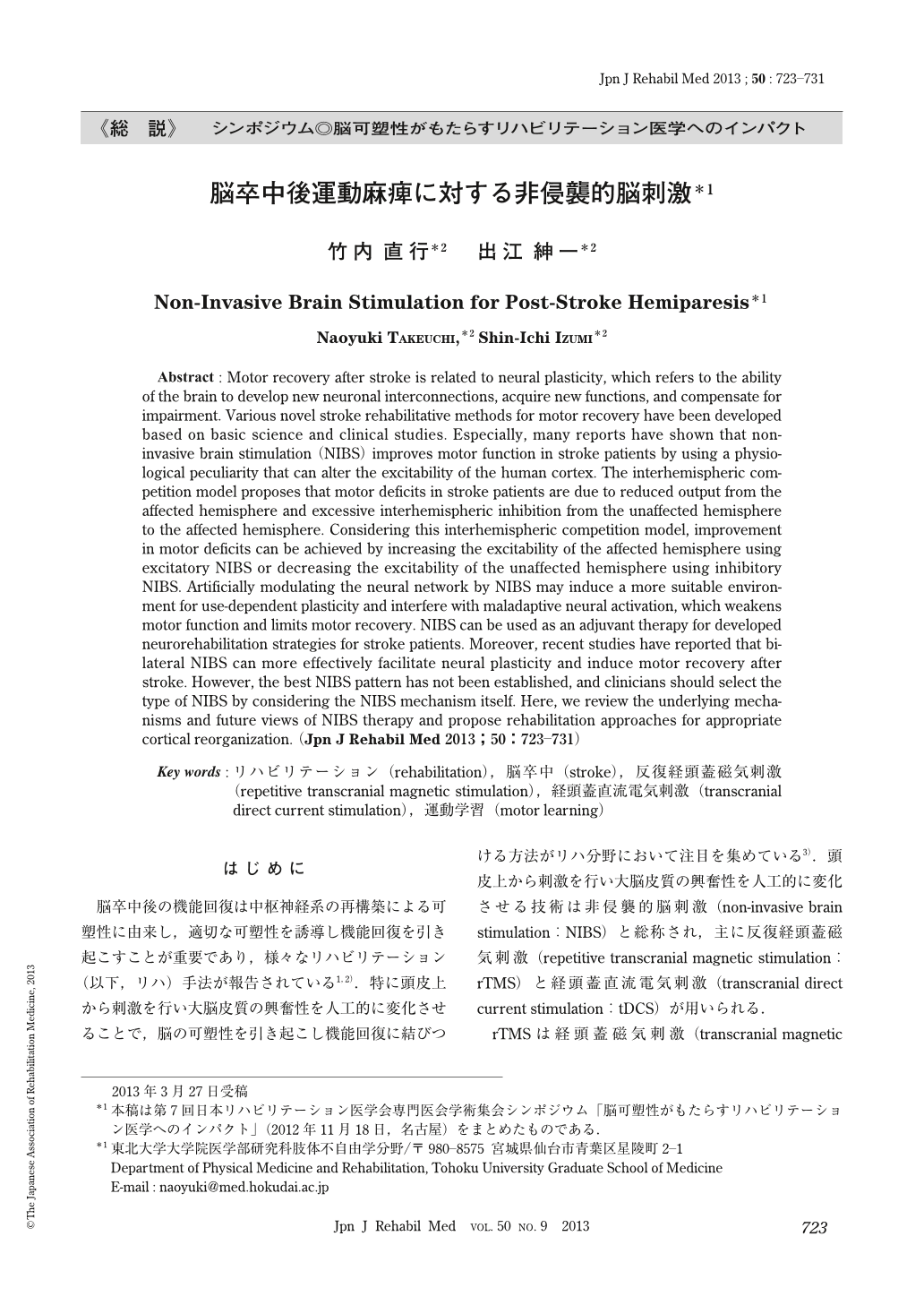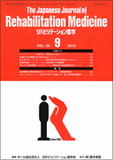Japanese
English
- 販売していません
- Abstract 文献概要
- 1ページ目 Look Inside
- 参考文献 Reference
はじめに
脳卒中後の機能回復は中枢神経系の再構築による可塑性に由来し,適切な可塑性を誘導し機能回復を引き起こすことが重要であり,様々なリハビリテーション(以下,リハ)手法が報告されている1,2).特に頭皮上から刺激を行い大脳皮質の興奮性を人工的に変化させることで,脳の可塑性を引き起こし機能回復に結びつける方法がリハ分野において注目を集めている3).頭皮上から刺激を行い大脳皮質の興奮性を人工的に変化させる技術は非侵襲的脳刺激(non-invasive brain stimulation:NIBS)と総称され,主に反復経頭蓋磁気刺激(repetitive transcranial magnetic stimulation:rTMS)と経頭蓋直流電気刺激(transcranial direct current stimulation:tDCS)が用いられる.
rTMSは経頭蓋磁気刺激(transcranial magnetic stimulation:TMS)を刺激強度,刺激頻度,刺激回数を変化させ反復して行うことによって大脳皮質の興奮性を変化させる手法である3).TMSは頭蓋上に置いたコイルに高電圧の高電流を流し,それにより生じる磁束が頭蓋骨に平行な大脳の良導体部分に渦電流を引き起こすことによって大脳皮質を刺激すると考えられている.抑制性に作用する低頻度rTMS(1Hz以下)と興奮性に作用する高頻度rTMS(5Hz以上)のような古典的rTMS手法以外に,現在では様々な条件でrTMSを実施し大脳皮質の興奮性を変化させる方法が報告されており,表1に代表的な刺激パターン,効果および文献を記載する3).
tDCSは表面電極を頭皮上に置き直流電流を通電する手法で動物実験を中心に報告されていたが,2000年ごろより生理的効果がヒトにおいても再確認され,その簡便さから注目を集め始めた手法である3).陽極刺激は大脳皮質の興奮性を増加させ,陰極刺激は大脳皮質の興奮性を低下させる効果を持つ.tDCSの神経系への作用機序に関しての詳細は明らかではないが,神経細胞の静止膜電位を変化させることによって生理学的効果をもたらすと考えられている3).rTMSとtDCSは非侵襲性に大脳皮質興奮性を変化させる点においては共通しているが,それぞれ刺激法に特徴があるため,臨床応用のためにはその特徴に留意する必要がある(表2)4,5).
NIBSを用いた脳卒中後運動麻痺に対する治療法は,NIBSにて皮質興奮性を変化させることで神経可塑性を促進し不適切な可塑性を抑制し機能回復を促すことを目的としている.しかしながらNIBSによる機能回復のメカニズムは不明瞭な点もあり効果的なNIBS方法はまだ確立されていない.本総説では,NIBSを用いた脳卒中後運動麻痺に対する治療のメカニズムおよび効果的な神経可塑性を引き起こす方法を考察したいと思う.
Abstract : Motor recovery after stroke is related to neural plasticity, which refers to the ability of the brain to develop new neuronal interconnections, acquire new functions, and compensate for impairment. Various novel stroke rehabilitative methods for motor recovery have been developed based on basic science and clinical studies. Especially, many reports have shown that non- invasive brain stimulation (NIBS) improves motor function in stroke patients by using a physiological peculiarity that can alter the excitability of the human cortex. The interhemispheric competition model proposes that motor deficits in stroke patients are due to reduced output from the affected hemisphere and excessive interhemispheric inhibition from the unaffected hemisphere to the affected hemisphere. Considering this interhemispheric competition model, improvement in motor deficits can be achieved by increasing the excitability of the affected hemisphere using excitatory NIBS or decreasing the excitability of the unaffected hemisphere using inhibitory NIBS. Artificially modulating the neural network by NIBS may induce a more suitable environment for use-dependent plasticity and interfere with maladaptive neural activation, which weakens motor function and limits motor recovery. NIBS can be used as an adjuvant therapy for developed neurorehabilitation strategies for stroke patients. Moreover, recent studies have reported that bilateral NIBS can more effectively facilitate neural plasticity and induce motor recovery after stroke. However, the best NIBS pattern has not been established, and clinicians should select the type of NIBS by considering the NIBS mechanism itself. Here, we review the underlying mechanisms and future views of NIBS therapy and propose rehabilitation approaches for appropriate cortical reorganization.

Copyright © 2013, The Japanese Association of Rehabilitation Medicine. All rights reserved.


